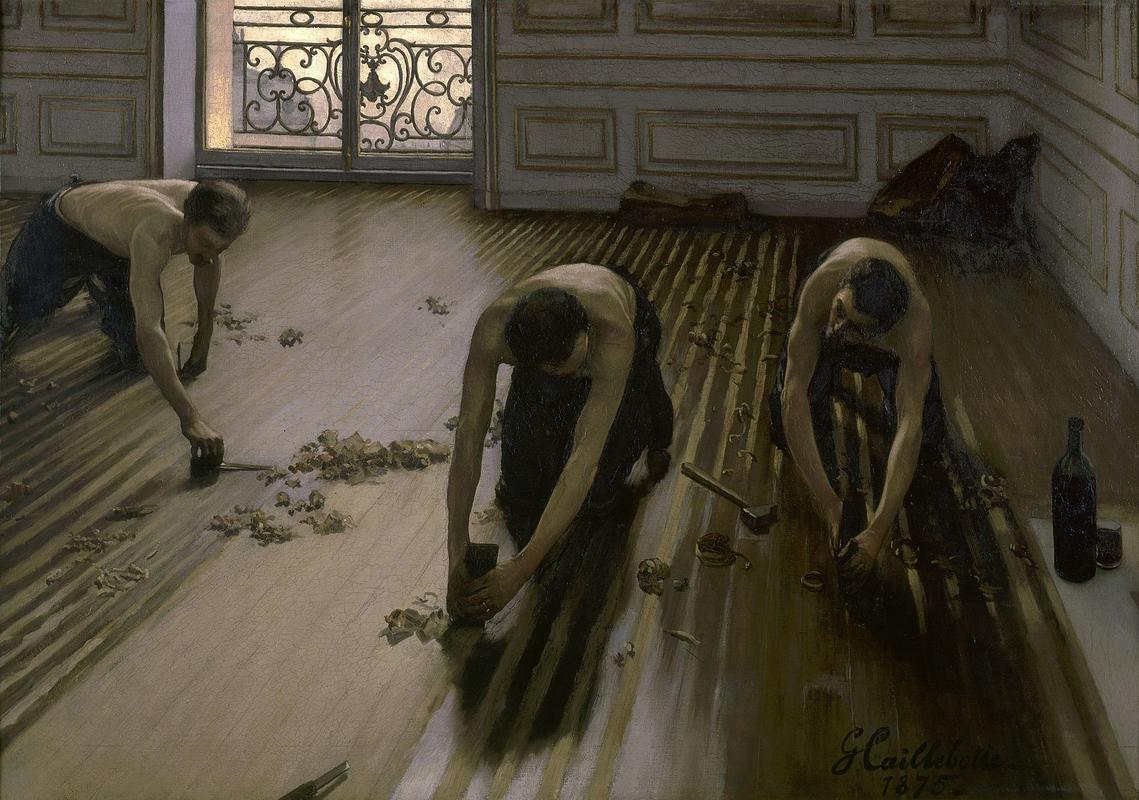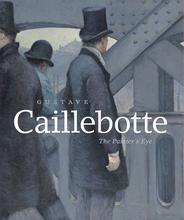More about The Floor Scrapers
- All
- Info
- Shop

Contributor
I don’t know about you, but I think the profession of “floor-scraper” just screams sex appeal.
Psych. I’m just joshin’. I’m not so much into floor-scrapers, but the French Impressionist Gustave Caillebotte definitely was. His painting Floor-Scrapers oozes with suppressed erotic desire.
This painting depicts three working-class, half-naked men scraping the floor of Caillebotte’s to-be studio. Caillebotte seems to eroticize the bodies of the men, situating them physically beneath the perspective of the viewer and elongating their arms and bodies to an impossible degree. The natural light flooding in through the window highlights the contracting muscles on the scrapers’ backs. I remember the first time I saw this painting I thought, “Damn, ok, I see you scrapers, I see you.”
While I personally find the image to be sexy, art critic Louis Enault declared, “Do the nude, gentlemen, if the nude suits you . . . But may your nude be handsome or don’t get involved with it!” Contrary to the conservative disgust that met this painting by members of the salon, Enault viewed the sinewy limbs and pale skin of the workers not as crude or vulgar subject matter, but as undesirable.
Often compared to Gustave Courbet’s The Stone Breakers, The Floor-Scrapers shares the subject matter of physical work. While Caillebotte’s Realist predecessor painted with a somewhat activist intention of humanizing the working class, Caillebotte just painted what was in front of him: the men working to make his studio suitable for use. The salon would not have accepted a plebian as acceptable subject matter for a painting, but Courbet changed this by making the work of the common people his central topic. Caillebotte does the same, in a way, yet his notorious wealth makes it unlikely that he intended to advocate for the working class. Wealthy members of French society at the time were often drawn to the working class male body rather than the aristocratic body. However, Caillebotte painted this during the 19th Century, at the beginning of the construct of homosexuality. So any semblance of *gay vibes* were a big no-no. But Mr. Money Bags Caillebotte couldn’t have cared less about the sale of his paintings because his artwork had no impact on his livelihood.
In short, Caillebotte was just a rich boy who didn’t want to leave his studio to go find peasants in the street to paint, so he figured he could just paint the peasants he hired to scrape the floors.
Sources
- Blank, Hanne. Straight: The Surprisingly Short History of Heterosexuality. Boston: Beacon Press, 2012.
- Broude, Norma. Gustave Caillebotte and the Fashioning of Identity in Impressionist Paris. New Brunswick, NJ: Rutgers University Press, 2002.
- “Gustave Caillebotte, The Floor Scrapers.” Smarthistory. Accessed July 12, 2019. https://smarthistory.org/gustave-caillebotte-the-floor-scrapers-les-rab….
- Marrinan, Michael. Gustave Caillebotte. Painting the Paris of Naturalism, 1872-1887. Los Angeles: Getty Trust Publications, 2017.
- Varnedoe, Kirk. Gustave Caillebotte. Yale University Press, 2000.
Featured Content
Here is what Wikipedia says about Les raboteurs de parquet
Les raboteurs de parquet (English title: The Floor Scrapers) is an oil painting by French Impressionist Gustave Caillebotte. The canvas measures 102 by 146.5 centimetres (40.2 in × 57.7 in). It was originally given by Caillebotte's family in 1894 to the Musée du Luxembourg, then transferred to the Musée du Louvre in 1929. In 1947, it was moved to the Galerie nationale du Jeu de Paume, and in 1986, it was transferred again to the Musée d'Orsay in Paris, where it is currently displayed.
Check out the full Wikipedia article about Les raboteurs de parquet














I’ll never look at shirtless floor scrapers the same.